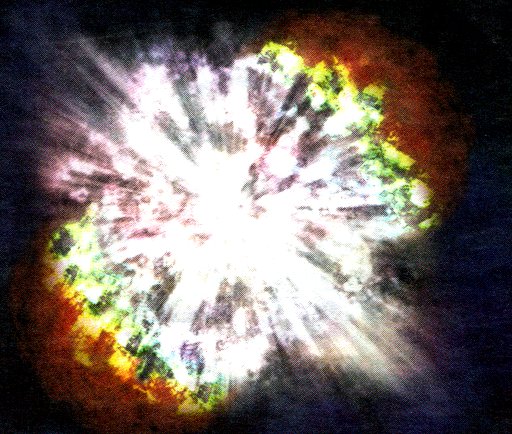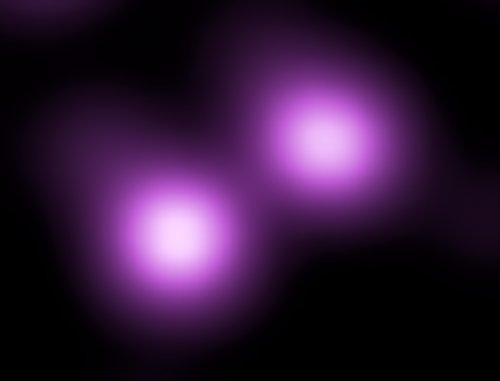Supernova discovered
 | ||||||||||||||||||||||||||||
| artist impression of the exploding star SN 2006gy | ||||||||||||||||||||||||||||
| Supernova discovered | ||||||||||||||||||||||||||||
|
According to observations by NASA's Chandra X-ray Observatory and
ground-based optical telescopes, the supernova SN 2006gy is the
brightest and most energetic stellar explosion ever recorded and may be
a long-sought new type of explosion. The top panel of this graphic is
an artist's illustration that shows what SN 2006gy may have looked likeif viewed at a close distance. The fireworks-like material in white
shows the explosion of an extremely massive star. This debris is pushing
back two lobes of cool, red gas that were expelled in a large eruption
from the star before it exploded. The green, blue and yellow regions in
these lobes shows where gas is being heated in a shock front as the
explosion material crashes into it and pushes it backwards. Most of the
optical light generated by the supernova is thought to come from debris
that has been heated by radioactivity, but some likely comes from the
shocked gas. The bottom left panel is an infrared image, using adaptive optics at the Lick Observatory, of NGC 1260, the galaxy containing SN 2006gy. The dimmer source to the lower left in that panel is the center of NGC 1260, while the much brighter source to the upper right is SN 2006gy. Thepanel to the right shows Chandra's X-ray image of the same field of view, again showing the nucleus of NGC 1260 and SN 2006gy. The Chandra observation allowed astronomers to determine that SN 2006gy was indeed caused by the collapse of an extremely massive star, and not the most likely alternative explanation for the explosion, the destruction of a low-mass star. If the supernova was caused by a white dwarf star exploding into a dense, hydrogen-rich environment, SN 2006gy would have been about 1,000 times brighter in X-rays than what Chandra detected. | ||||||||||||||||||||||||||||
 | ||||||||||||||||||||||||||||
| ||||||||||||||||||||||||||||
|
| ||||||||||||||||||||||||||||
| Source : http://chandra.harvard.edu/photo/2007/sn2006gy/ | ||||||||||||||||||||||||||||
